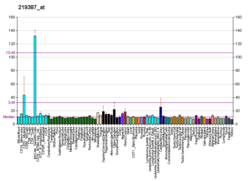| CCDC88A |
|---|
|
| Identifiers |
|---|
| Aliases | CCDC88A, APE, GIRDIN, GIV, GRDN, HkRP1, KIAA1212, coiled-coil domain containing 88A, PEHO, PEHOL |
|---|
| External IDs | OMIM: 609736; MGI: 1925177; HomoloGene: 41180; GeneCards: CCDC88A; OMA:CCDC88A - orthologs |
|---|
| Gene location (Human) |
|---|
 | | Chr. | Chromosome 2 (human)[1] |
|---|
| | Band | 2p16.1 | Start | 55,287,842 bp[1] |
|---|
| End | 55,419,895 bp[1] |
|---|
|
| Gene location (Mouse) |
|---|
 | | Chr. | Chromosome 11 (mouse)[2] |
|---|
| | Band | 11|11 A3.3 | Start | 29,323,658 bp[2] |
|---|
| End | 29,460,808 bp[2] |
|---|
|
| RNA expression pattern |
|---|
| Bgee | | Human | Mouse (ortholog) |
|---|
| Top expressed in | - internal globus pallidus
- corpus callosum
- ventricular zone
- ganglionic eminence
- Achilles tendon
- subthalamic nucleus
- buccal mucosa cell
- inferior ganglion of vagus nerve
- tendon of biceps brachii
- testicle
|
| | Top expressed in | - Rostral migratory stream
- barrel cortex
- tail of embryo
- genital tubercle
- lateral septal nucleus
- lateral geniculate nucleus
- mammillary body
- ventromedial nucleus
- spermatid
- anterior amygdaloid area
|
| | More reference expression data |
|
|---|
| BioGPS | 
 | | More reference expression data |
|
|---|
|
| Gene ontology |
|---|
| Molecular function | - protein homodimerization activity
- phosphatidylinositol binding
- actin binding
- microtubule binding
- protein kinase B binding
- dynein light intermediate chain binding
- G-protein gamma-subunit binding
| | Cellular component | - cytoplasm
- Golgi apparatus
- cell projection
- endoplasmic reticulum
- lamellipodium
- membrane
- cytoplasmic vesicle
- cytosol
- plasma membrane
- cell leading edge
- centrosome
- centriole
- cytoskeleton
- ciliary basal body
- COPI-coated Golgi to ER transport vesicle
| | Biological process | - regulation of actin cytoskeleton organization
- nervous system development
- DNA replication
- membrane organization
- cell migration
- lamellipodium assembly
- activation of protein kinase B activity
- regulation of DNA replication
- TOR signaling
- regulation of protein phosphorylation
- regulation of cell population proliferation
- regulation of neuron projection development
- cell projection organization
- cytoskeleton-dependent intracellular transport
- cytoplasmic microtubule organization
- positive regulation of cilium assembly
- positive regulation of protein localization to cilium
| | Sources:Amigo / QuickGO |
|
| Orthologs |
|---|
| Species | Human | Mouse |
|---|
| Entrez | | |
|---|
| Ensembl | | |
|---|
| UniProt | | |
|---|
| RefSeq (mRNA) | |
|---|
NM_001135597
NM_001254943
NM_018084
NM_001365480 |
| |
|---|
NM_176841
NM_001363368
NM_001363369 |
|
|---|
| RefSeq (protein) | |
|---|
NP_001129069
NP_001241872
NP_060554
NP_001352409 |
| |
|---|
NP_789811
NP_001350297
NP_001350298 |
|
|---|
| Location (UCSC) | Chr 2: 55.29 – 55.42 Mb | Chr 11: 29.32 – 29.46 Mb |
|---|
| PubMed search | [3] | [4] |
|---|
|
| Wikidata |
| View/Edit Human | View/Edit Mouse |
|


















